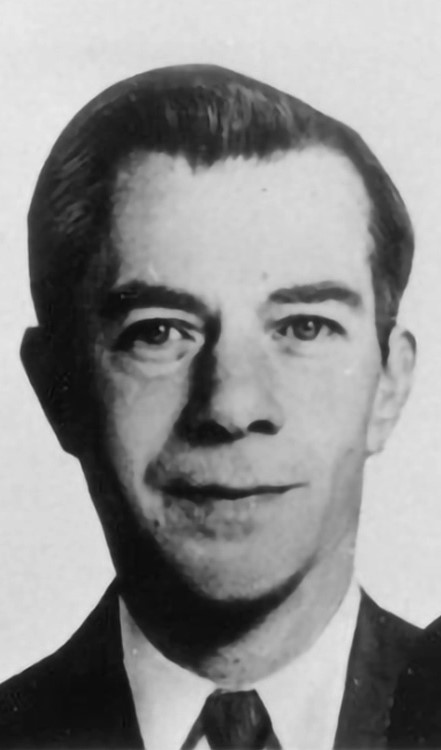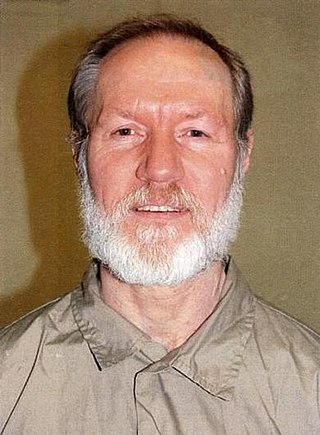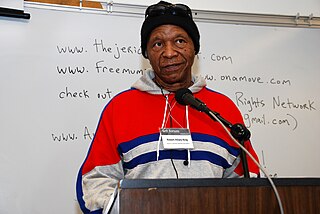Related Research Articles

Bank robbery is the criminal act of stealing from a bank, specifically while bank employees and customers are subjected to force, violence, or a threat of violence. This refers to robbery of a bank branch or teller, as opposed to other bank-owned property, such as a train, armored car, or (historically) stagecoach. It is a federal crime in the United States.
Charles Arthur Salvador, better known as Charles Bronson, is a British criminal who has been referred to in the British press as the "most violent prisoner in Britain" and "Britain's most notorious prisoner". He has spent periods detained in the Rampton, Broadmoor and Ashworth high-security psychiatric hospitals.

William Francis Sutton Jr. was an American bank robber. During his forty-year robbery career he stole an estimated $2 million, and he eventually spent more than half of his adult life in prison and escaped three times. For his talent at executing robberies in disguises, he gained two nicknames, "Willie the Actor" and "Slick Willie". Sutton is also known as the namesake of the so-called Sutton's law although he denied originating it.

Harry "Pete" Pierpont was a Prohibition era gangster, convicted murderer and bank robber. He was a friend and mentor to John Dillinger.
Robert Vernon Toye, nicknamed "Blind Bob" is a US bank robber who is legally blind.

Christopher John Boyce is a former American defense industry employee who was convicted of selling United States spy satellite secrets to the Soviet Union in the 1970s.
Roy G. Gardner was an American criminal active during the 1920s. He stole a total of more than $350,000 in cash and securities and several times escaped from custody. He is said to have been the most hunted man in Pacific Coast history, having had a $5,000 reward for his head three times in less than a year, and newspapers in the West referred to him as the "Smiling Bandit", the "Mail Train Bandit", and the "King of the Escape Artists" He is a former prisoner of Alcatraz Federal Penitentiary (1934–38).

The Metropolitan Correctional Center, Chicago is a United States federal prison in Chicago, Illinois, which holds male and female prisoners of all security levels prior to and during court proceedings in the Northern District of Illinois, as well as inmates serving brief sentences. It is operated by the Federal Bureau of Prisons, a division of the United States Department of Justice.

Thomas Edward Silverstein was an American criminal who spent the last 42 years of his life in prison after being convicted of four separate murders while imprisoned for armed robbery, one of which was overturned. Silverstein spent the last 36 years of his life in solitary confinement for killing Corrections Officer Merle Clutts at the Marion Penitentiary in Illinois. Prison authorities described him as a brutal killer and a former leader of the Aryan Brotherhood prison gang. Silverstein maintained that the dehumanizing conditions inside the prison system contributed to the three murders he committed. He was held "in a specially designed cell" in what is called "Range 13" at ADX Florence federal penitentiary in Colorado. He was the longest-held prisoner in solitary confinement within the Bureau of Prisons at the time of his death. Many prison guards refused to talk to Silverstein out of respect for Clutts.

Menard Correctional Center, known prior to 1970 as Southern Illinois Penitentiary, is an Illinois state prison located in the town of Chester in Randolph County, Illinois. It houses maximum-security and high medium-security adult males. The average daily population as of 2007 is 3,410.

The Angola Three are three African-American former prison inmates who were held for decades in solitary confinement while imprisoned at Louisiana State Penitentiary. The latter two were indicted in April 1972 for the killing of a prison corrections officer; they were convicted in January 1974. Wallace and Woodfox served more than 40 years each in solitary, the "longest period of solitary confinement in American prison history".

Morris Lynn Johnson is a Kentucky-born criminal, whose crimes include armed robbery, escape and rescue, bank robbery, and assaulting a police officer. He was briefly listed on the FBI's Ten Most Wanted list in 1976.

Henri Theodore Young was an American convicted bank robber and murderer who, while serving one of a series of prison terms, attempted a 1939 escape from Alcatraz Federal Penitentiary with four other inmates. During the escape attempt two inmates were shot, and one died of his wounds. All survivors were quickly recaptured. Two of the men, Young and Rufus McCain, were sentenced to solitary confinement and served the terms at Alcatraz for a period of three years. Eleven days after re-entering the Alcatraz general prison population in 1942, Young murdered fellow escapee McCain.
Johnny Madison "The Shootist" Williams Jr. is one of the most successful bank robbers in American history. After his arrest on July 9, 1994, Williams confessed to 56 bank robberies across the states of California, Texas, and Washington state over an eight-year period, beginning in 1986, usually with the help of his wife, Carolyn, usually known as Carol. He kept a meticulous record of his heists, reporting his career total as $879,357.
Frank Nash was an American bank robber, and has been called "the most successful bank robber in U.S. history." He is most noted for his violent death in the Kansas City Massacre. Nash spent part of his childhood in Paragould, Arkansas and was arrested in Hot Springs, Arkansas the day before his death.
Colorado State Penitentiary is a Level V maximum security prison in the U.S. state of Colorado. The facility is part of the state's East Cañon Complex, together with six other state correctional facilities of various security levels.

Robert Hillary King, also known as Robert King Wilkerson, is an American known as one of the Angola Three, former prisoners who were held at Louisiana State Penitentiary in solitary confinement for decades after being convicted in 1973 of prison murders.
The British Columbia Penitentiary was a federal maximum security prison located in New Westminster, British Columbia, Canada. The BC Penitentiary operated for 102 years, from 1878 until it was decommissioned in 1980. It was the first federal penal institution west of Manitoba. Gate house was sold on September 8,2021 and was renamed Governors Castle by new owners Vikram Bajwa and Sunny Sodhi. Colliers international Appraised the Building at $8,950,000,additional open space for $4,500,00, totaling $13,450,000. at time of purchase by Governors Court Inc.

Rufe Persful was an American criminal, convicted for murder, kidnapping and robbery. He was considered one of the most dangerous criminals of his era by the authorities. Convicted of the murder and robbery of an elderly man at the age of 18, he was sentenced to 15 years in Arkansas State Penitentiary, but unlike a standard prison, it involved farm labor. He was given the task of shooting fellow inmates with a shotgun if they attempted to escape. He killed and disabled many prisoners during his time at the Arkansas Penitentiary, punctuated by periods of parole as a reward for his prison protection, and then re-offending and being sent back to resume his role. In December 1934, Persful was convicted for kidnapping and robbery in Paragould, Arkansas and sentenced to 20 years, after which he was transferred to United States Penitentiary, Atlanta. Two inmates recognized him from Arkansas and word spread of his killing of fellow inmates and he began being severely abused. He was transferred to Alcatraz Federal Penitentiary a year later but was recognized and continued to be tortured by his fellow inmates because of his past offenses. In 1937, Persful attempted to cut off his hands in sheer desperation of his experiences at Alcatraz and was diagnosed with schizophrenia. He was eventually sent to McNeil Island Penitentiary, where he was again recognized and suffered much abuse from his fellow inmates, despite being heavily watched over by the prison staff. Persful was released in April 1948 and moved in with a relative in Gary, Indiana, never to be convicted of a crime again.

William L. "Wild Bill" Carlisle was one of the last train robbers of the American West known as the "Robin Hood of the Rails" and "The White-Masked Bandit".
References
- ↑ Salon.com, August 2004.
- 1 2 3 4 5 6 7 East Bay Express, October 2002.
- ↑ The Rumpus, January 2009.
- ↑ Reddit.com, June 2014.